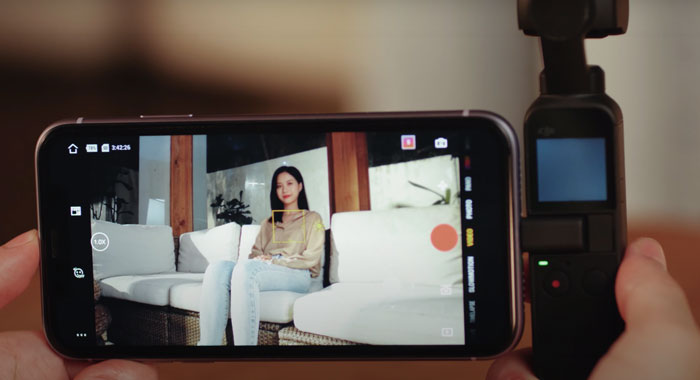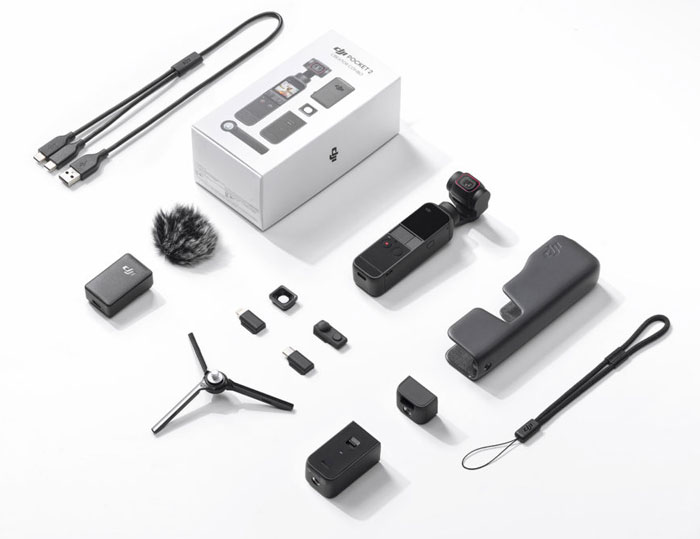NEW: DJI Pocket 2
DJI have recently announced the follow up to the original Osmo Pocket, now called the DJI Pocket 2. Like with the DJI Osmo Mobile gimbal range, the name has been simplified and the “Osmo” has been dropped.
Both devices work like a 3 axis gimbal, except the camera and the gimbal are combined. So no need to mount your smartphone or other camera, no fiddling around with bluetooth and so on, which means you can get shooting faster.
But what else is different?
DJI Pocket 2: 64MP Photos
The new Pocket 2 now produces photos at up to 64MP, which is quite a jump from the Osmo Pocket’s maximum of 12MP.
The new device is also slight bigger than the original and weighs 1 gram more (117 grams vs 116 grams).
DJI Pocket 2: Larger Sensor
The original Osmo Pocket had a 1/2.3-inch sensor, which has now been upgraded to a 1/1.7-inch in the new model. What difference does a bigger sensor make? Apart from higher resolution images, a larger sensor usually performs better in low light situations.
However, the limit of the device when it comes to shooting video is 4K at 60fps, which is the same as the original. But the 64MP sensor allows 4x digital zoom without reducing quality (in a 1080p HD video). Or 8x zoom in 64MP photo mode.
In addition, DJI say an update will introduce HDR shooting capability. HDR adds dynamic range, but not as well as HDR10+ or the Dolby Vision which is now included in the new iPhones. HDR only uses one set of metadata for the whole video, while HDR10+ and Dolby Vision are working frame by frame.
When it comes to slow motion, the Pocket 2 can shoot at 240fps at 1080p (compared to only 120fps in the old Osmo Pocket).
DJI Pocket 2: More ISO
The new device has an ISO range of 100-6400 for photo and video, while the old Osmo Pocket has a range of 100-3200. So, one stop more.
DJI Pocket 2: Wider Field of View
The new device will increase the field of view from 80 degrees to 93 degrees. So this will help vloggers who want to take up less of the screen when filming themselves.
The new wider 20mm lens (compared to the old Osmo Pocket’s 25.7mm lens) also a bigger aperture (from f/2.0 to f/1.8) which again helps when shooting in low light situations. A bigger aperture lets in more light (as well as adding a slightly shallower depth of field).
A conversion lens accessory allows you to add additional wideness to the lens, moving it closer to a 15mm. So this is even wider still. The DJI accessory conversion lens snaps into place, with the help of some magnets as well as a clip.
DJI Pocket 2: Better Audio
The DJI Pocket 2 adds 4 microphones compared to the Osmo Pocket’s 2 mics and this results in a much improved audio recording experience. One of the complaints from the original was the weak audio, so that’s been addressed in the updated device.
There’s also Audio Zoom and SoundTrack, which use software to boost the audio performance, based on the camera’s direction and focus. In addition, it’s now possible to connect a wired or wireless microphone.
If you opt for the Creator Combo version, you even get a wireless microphone as one of the additional extras.
DJI Pocket 2: Battery Life
The new device has a 875 mAh capacity, which is the same as with the old Osmo Pocket. So no improvement there and you will get the same 140 minutes of use time per charge (and a 73-minute charge time).
DJI Pocket 2: Creator Combo
You can purchase the basic Pocket 2 device or, if you can stretch your budget, there is the Creator Combo. This package comes with a lot of extras, including that wide angle lens adapter, the mini tripod and much more.
DJI Pocket 2: Modes
The DJI Pocket 2 has various modes which give you extra creative options for shooting. Things like Motionlapse, Timelapse, ActiveTrack and so on. But you can also connect your smartphone and use the Mimo app (which is the same app used for the OM 3 and 4 gimbals).
There’s also an AI Editor, which is basically software which cuts your videos together for you. If you have a smartphone with a similar feature, you will know how this usually turns out (a bit random). Apps like Google Photos also do this, cutting any video clips uploaded into a sequence which hopes to impress you.

Eager to learn more?
Join our weekly newsletter featuring inspiring stories, no-budget filmmaking tips and comprehensive equipment reviews to help you turn your film projects into reality!
Simon Horrocks
Simon Horrocks is a screenwriter & filmmaker. His debut feature THIRD CONTACT was shot on a consumer camcorder and premiered at the BFI IMAX in 2013. His shot-on-smartphones sci-fi series SILENT EYE featured on Amazon Prime. He now runs a popular Patreon page which offers online courses for beginners, customised tips and more: www.patreon.com/SilentEye


